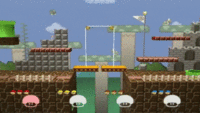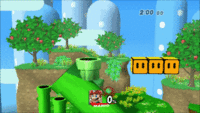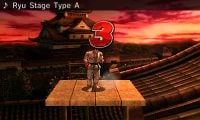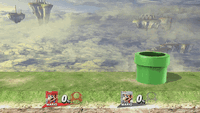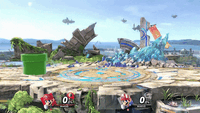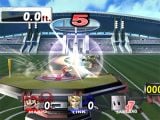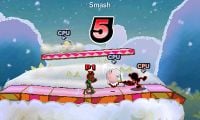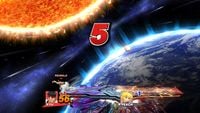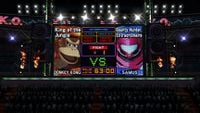Match timer

The match timer is an element that displays the time remaining in a match on the top-right corner of the screen (top-center in Super Smash Bros. Melee). It can be toggled in Versus Mode matches and adjusted between 1 and 99 minutes (with thirty-second intervals for matches under two minutes in Super Smash Bros. Ultimate) in the Rules menu. It can also appear with predetermined time limits in Bonus Stages, single-player modes, as well as on the Online Practice Stage when waiting in a lobby. The timer is formatted as H:MM:SS.ss (hours, minutes, seconds, centiseconds), with centiseconds introduced after Melee and hours introduced after Super Smash Bros. 4.
Other related timers are exclaimed by the Announcer, and text within them will be affected based on region or language.
Pre-match timer
The pre-match timer appears before the start of a match, counting down from three before starting the match with "GO!". During this time, fighters make their on-screen appearance, and the music track is displayed in the top left-hand corner starting with Brawl. In Ultimate, the versus splash screen appears prior to the match.
In Super Smash Bros., the countdown uses a stoplight with lights activating from left to right. It first starts with a red light and lowers from off-screen, then each of the three amber lights activate as the seconds pass, and a blue light labeled "GO" lights up before the stoplight rises back up.
In Melee, the countdown uses a meter, with a timer counting down as it rapidly depletes and the text "Ready". A variation of this, lacking the timer and on-screen appearances, is used during single-player modes such as All-Star and Adventure Mode: World of Light starting with Brawl.
From Brawl onwards, the countdown uses large numbers in the top center of the screen, similarly to the final countdown timer, and has different colors for each of them: three (blue), two (green) and one (yellow). All numbers are red in Smash 4 and then to flaming orange-red in Ultimate. When "GO!" appears onscreen, it will have a different color depending on the game: vermilion (Super Smash Bros.), blackish-yellow, (Melee), brown (Brawl), silver (Smash 3DS), gold (Smash for Wii U), and flaming orange-red (Ultimate).
- NessOnScreenAppearanceMelee.gif
In Melee and single-player modes since Brawl.
Final countdown timer
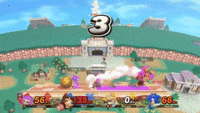
The final countdown timer counts down the last five seconds of a match, before ending with "TIME!" (“TIME UP” in other regions) and either declare a winner or commence a Sudden Death match. In competitive play, this event is usually referred to as a time out. In addition to versus matches, the timer appears in single-player modes like Race to the Finish and Trophy Rush.
In Smash 64, the announcer exclaims the timer with no visual aid. From Melee onwards, each remaining second is punctuated by a large number in the top center of the screen, with each number getting subsequently larger (except in Super Smash Bros. for Wii U and Ultimate). Just like the pre-match timer and the "GO!" message, the numbers have a different color. In Melee, the numbers are crimson before it was changed to red in Brawl and SSB4, and then to silver in Ultimate. The timer's appearance activates equipment with the Countdown bonus effect, and from Smash 4 onwards, prevents Star KOs and Screen KOs from happening, except during the End of Day KO Glitch. This also applies to the Finish Zoom in Ultimate.
- MarioHomeRunContestMeleeLastSecond.jpg
In Melee.
Gallery
- SSBM Timer.jpg
In Melee.
On the Boxing Ring’s Jumbotron in Super Smash Bros. for Wii U.
Trivia
- When there are only thirty seconds left, the current music changes on some stages. This applies to five stages: Mushroom Kingdom, Mushroom Kingdom, Mushroom Kingdom II, Suzaku Castle, and Moray Towers.
- In Suzaku Castle's case, this applies to music taken directly from Street Fighter II or Super Street Fighter II (barring Player Select Type A and B in Ultimate).
- In Moray Towers' case, this applies to music taken directly from Splatoon or Splatoon 2 (with the exceptions of Split & Splat, Octoweaponry, I Am Octavio, Calamari Inkantation, and Deluge Dirge).
- In version 8.1.0 of Ultimate; Battlefield, Final Destination, Small Battlefield, and Big Battlefield share the same trait when using stage music from Street Fighter, Splatoon or Super Mario.
